| The Impact of the 1998 Aitape Tsunami at Jayapura, Indonesia Nelson Joku Geosciences Division, University of Papua New Guinea | ||
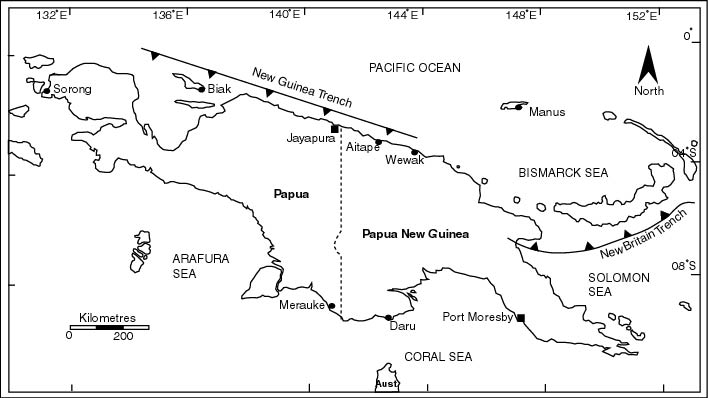 Figure 1: Map shows the location of Aitape and Jayapura and the New Guinea Trench.
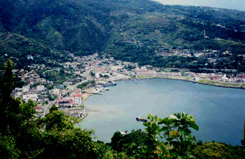 Figure 3: Photograph of Jayapura city, looking north.
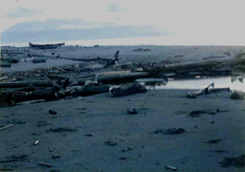 Figure 5: Photograph of debris carried across the beach by the tsunami waves (locality 1-Skouy Saey village). The view is to the west, towards Jayapura, with the Cyclops Range in the background.
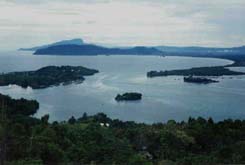 Figure 7: Photograph looks east across Tobati and Engross villages (on the peninsulas in the foreground) to Yotefa Bay (middle ground). Holtekamp is in Yotefa Bay.
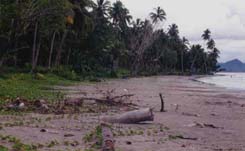 Figure 9: Photograph of logs partly buried in sand by the action of seiche waves at Holtekamp beach.
|
Abstract An investigation in August 1999 confirmed that the tsunami that struck the Aitape coast of Papua New Guinea on 17 July 1998 caused 2 m waves along the coast as far west as Jayapura and beyond, in the Indonesian province of Papua, 190-250 km west of Aitape. Most damage was caused by the backwash from the waves. Bodies that were presumed to be those of some of the Aitape victims were seen floating at sea off Jayapura five or six days after the tsunami. Introduction The destructive tsunami that struck the Aitape coast of Papua New Guinea (PNG) on the evening of 17 July 1998 caused minor damage as far west as the village of Wutung, 160 km from Aitape (Figs. 1, 2; Kawata et al., 1999a, b). Wutung is just east of the international border between Papua New Guinea (PNG) and Indonesia. Investigators at the time did not cross the border into Indonesia and, as far as we are aware, there was no formal investigation or reporting of the effects of the tsunami by the Indonesian authorities or scientific community. However, there were informal and unconfirmed reports and newspaper stories that the tsunami had caused waves as high as 2 m in Jayapura, the Indonesian provincial capital, and that bodies had been seen in the sea or had been washed ashore (The National newspaper, Port Moresby, 29 July 1998; see Appendix 1). With the objective of confirming these reports, the author visited Jayapura in August 1999 (Appendix 2) and spent four days talking with eye witnesses and examining physical evidence of the passage of the tsunami. The results of these enquiries are presented in this paper. The Setting Jayapura is the capital of Indonesian province of Papua (previously Irian Jaya). The city has a population of around 200,000 and a further 120,000 people live in the adjacent region (Badan Pusat Statistik, 2002). The city is located on the northwestern shore of the east-facing Yos Sudarso Bay, also known as Humboldt Bay, at the eastern end of the Cyclops Range (Fig. 2). The bay is semi-circular and the mouth, 10 km across (Fig. 2). Access to Jayapura is by daily air services from other centers in Indonesia, and by 45 km of sealed road from Wutung in PNG. Wutung is connected by road to Vanimo, from where air services connect to other parts of PNG. Currently there is no scheduled air service between Vanimo and Jayapura. This Investigation Enquiries were made at settlements between Wutung and Jayapura and at G Base Beach (locality 5, Fig. 2). Because of security concerns at the time of the investigation it was not possible to visit the Ormo coast and Demta Headland (localities 6 and 7, Fig. 2). However, it was possible to interview people who had information from these localities. Interviews with eye witnesses were conducted using a standard set of questions (Appendix 3) that related not only to the 1998 tsunami but also to recollections of past tsunamis, and awareness of tsunami warning signs. The interviews were conducted in the Indonesian lingua franca, Bahasa Indonesian, and transcribed into English. Although it was more than a year since the tsunami had struck this coast memories of the events were still fresh in people's minds and some physical evidence of the passage of the tsunami remained. Eye-witnesses provided information on the number and shape of the waves, the wave heights and run-up, and the extent of inundation. In some cases the information could be confirmed by the presence of vegetation that had died due to salt water inundation, and by deposits of water-transported debris. Scour channels through the beach front berm were preserved in places. Results Skouw Saey (locality 1, Fig. 2) The village of Skouw Saey is on low-lying sandy coast a few km west of the international border. The village is 200-300 m from the water's edge behind a grove of coconut palms. The beach has a slope of less than three degrees (Figs. 4, 5). Eyewitness Nolita Palora, a 36 years old, was at her home near the beach on the afternoon of 17 July 1998. She observed three waves about 2 m high approaching the coast from the east or east-northeast, and spaced about 1 minute apart. The waves broke on the slope at the front of the beach and progressed for 50 m, as far as the beach front berm (Fig. 4), at which point the water was knee deep (< 50 cm). The first wave receded to sea before the second wave came ashore. A thunderous noise as of a strong wind and breaking waves accompanied the waves. She estimated the time of arrival of the waves as between 5 and 6 PM local time (0800-0900 hours UT). A second eye-witness, Yowel Rolo, 69 years old male, said that the waves arrived at 7 PM local time (8 PM PNG time, 1000 hours UT). Neither of the witnesses felt any earth tremors. Both recalled that the waves breaking on the shore did not present a threat to the villagers but the force with which the water retreated back to the sea caused grave concern. The back-flow cut scour channels, uprooted some coconut trees (Fig. 6), buried logs and carried debris out to sea. Skouw Mabo (locality 2). Skow Mabo village is immediately west of Skouw Saey and shares the same gently sloping sandy waterfront. The village is less than 100 m from the water's edge. As with Skouw Saey, the villagers reported waves 2 m high breaking on the shore and progressing 50 m inland and, as at Skouw Saey, villagers were more concerned about the force of the back-flow, rather than the force of the incoming waves. The backwash scoured channels, uprooted coconut trees, buried logs and washed several canoes out to sea. No earth tremors were felt. Holtekamp beach (locality 3). Holtekamp beach is within Yotefa Bay on a shoreline that faces to the northwest; it is protected by the hook-shaped headland of Diar Point (Fig. 2). The beach is 50-100 m wide and has a gentle slope. A logging company stores logs on the beach, ready for transshipment. Waves 2 m high approached the beach at an angle, broke about 20 m from the beach, and flowed 50 m inland. One eye-witness, Godlief Samallo, recalled hearing a sudden noise before the waves arrived. He saw a succession of many waves creating a whirlpool-like effect (Fig. 8). The waves or seiche continued for three days, each wave penetrating about 20 m inland. The waves uprooted trees, buried trees on the beach (Fig. 9), and cut a scour channel. Some of the stacked logs were carried out to sea. According to observer Alfred Pattipeme, an earthquake on the evening of the tsunami was unusual in that it was at first strongly felt, then became weaker, then strongly felt again. Hamadi market (locality 4). Hamadi market is on an east-facing promontory within Yos Sudarso Bay and is partly protected by Snada Point (Fig. 2). From this location, waves 2 m high were observed in the bay. The waves struck the beach and progressed 10-20 m inland. The backwash was sufficient to tear large canoes from their moorings. A seiche wave continued for several days. Base G beach (locality 5). Base G beach faces eastward toward open ocean, northwest of Snada Point. Here waves 2 m high struck at an angle to the beach at 7-8 PM local time (1000-1100 hours UT) and progressed 20-30 m inland. The backwash from the waves was strong enough to uproot trees, and to carry canoes away from their moorings. An unusual sound, like that of a passing ship or noise of a helicopter (wop-wop sound) was said to have accompanied the waves. A weak earthquake was felt. Yusup Makanuwey reported that on the southwest side of Snada Point a 2 m seiche wave developed and continued for more than an hour (10 -11 PM local time, 1300-1400 hours UT). The waves penetrated inland for 200 m, at which point the water was less than 1.5m deep. Ormo coastline (locality 6). The Ormo coastline faces east and is on the east side of a small promontory. The tsunami waves reached this area on the Friday night while the eye-witness, Didimus Ireew, and friends were fishing on a reef. The fishermen felt three waves which lifted and dropped their dinghy as in an oscillatory motion. Because it was dark they did not see the waves, nor the direction of their approach. An unusual loud sound preceded the arrival of the waves. The fishermen had to hold fast to their aluminum motorized fishing canoes, and made their way to shore as quickly as they could, because the back flow from the waves threatened to pull them out to sea. Once they reached the shore there was what seemed an unusual calmness and darkness. Water at the river mouth where they came ashore was unusually warm. They did not feel an earthquake. Demta headland (locality 7). Demta headland, 70 km west of Jayapura, was not visited because of internal security problems at the time of survey. A Jayapura resident who visited Demta headland reported that waves about 2 m high reached the headland, probably on the evening of Friday 17 July. The waves approached the beach at an angle and were followed by a strong backwash. Bodies of Tsunami Victims Fishermen from Hamadi and Skow Mabo confirmed press reports (The National, Port Moresby, 29 July 1998) that bodies of tsunami victims were seen floating at sea. Fishermen from Skow Mabo saw eight bodies on 22 July, five days after the tsunami The Hamadi fishermen recovered a skull with betel-nut-stained teeth from the stomach of a shark caught six days after the tsunami. There was an unconfirmed report that a body of a male youth, 16-18 years old, was found in a drifting canoe by villagers at Demta headland. He was wearing a traditional wristband made of beads and had in his possession a PNG two-kina plastic note. The youth is said to have been buried in the village. Other Phenomena Villagers at Skouw Saey reported that red bubbles, accompanied by a distinctive smell, appeared in the sea on Thursday 16 July 1998 at about 8 PM local time, a day prior to the tsunami hitting Aitape. The villagers have a customary belief that whenever red bubbles appear in the sea there will be some sort of unusual event, possibly but not necessarily a disaster, not necessarily in the local village but somewhere in the vicinity. At such times they take special care when going out fishing and do not to let their children play by the sea. Recollections of Past Tsunamis According to Yowel Rolo, the village of Skouw Saey has been relocated inland five times since the early 1930s, each time because of a tsunami. In the early 1930s the village was swept away by a probable tsunami in the early hours of the night. The story goes that, thanks to an alarm sounded by a man who went to the beach to relieve himself, all of the people in the village fled inland to safety and there was no loss of life. There were three closely spaced waves that seemed to hit the village all at once, in single sweep. The second village was built about 100 m inland from the first but had some houses destroyed by strong waves suspected to be tsunami-related. Since then, the village has moved inland twice after strong waves, waist deep, flowed under the houses. The houses are elevated above the ground on high posts. Yowel Rolo also described a tsunami-related event that occurred in Skouw Mabo in 1957. A body of turning water, about 3 m high and described as whirlpool, caught and drowned a man who was near the beach. In 1952, a house in Engross village (Engross-Tobati area, Figs. 2, 7) was destroyed by waves. The waves were high and lasted through the night. An interviewee at G Base Beach also recalled that tsunami waves had struck Engross and Tobati on two different occasions, and that in one instance the waves were as high as 10 m. This was in the 1960s, when the eyewitness was a small boy. Tsunami Awareness Most interviewees did not understand the likely causes of tsunamis, but some (for example Yowel Rolo of Skouw Saey) knew from experience the warning signs of a tsunami: a strongly felt earthquake accompanied by the receding of the sea to expose the seabed. Based on my interviews and discussions with local people, it seems likely that the general level of tsunami awareness and understanding in the Jayapura area is poor. Conclusion and Discussion At all locations near Jayapura where enquiries were made, and as far as 70 km west of Jayapura, three waves about 2m high approached the coast from the east-northeast and swept inland for distances varying between 10 and 50 m. The waves were said to be about one minute apart and to have arrived at 7 PM local time or between 7 - 8 PM local time (1000 - 1100 hours UT). Times are not precise because most villagers to not have clocks or pay close attention to determining the time of day. The reported arrival times compare with the arrival of the tsunami waves on the Aitape coast at 0900-0915 hours UT (Davies et al., this volume). The waves caused some damage but no lives were lost. Most damage was caused by the backwash from the waves, as the waters returned to the sea. The strength of the backwash was sufficient to uproot trees and to carry away logs stacked on the beach and canoes from their moorings. Seiche waves were established in Yos Sudarso Bay and in Yotefa Bay, and continued for several days. Bodies presumed to be those of tsunami victims from the Aitape coast were seen floating at sea by fishermen from Skouw Mabo and Hamadi market, five or six days after the tsunami. A westward longshore drift is likely at this time of year because of the prevailing southeast trade winds. A number of observers reported unusual sounds that preceded (in some cases) or accompanied the waves, and one observer noted that the water was warm after the waves had passed. Similar observations were made by many of the survivors on the Aitape coast. The reports of past tsunamis are intriguing and warrant further investigation. The extreme heights for waves reported to have hit Engross and Tobati in the 1960s have not been independently confirmed, but should not be discounted out of hand. The shape of Yos Sudarso Bay would have a focusing effect for any tsunami wave or storm surge that enters the bay, and could result in anomalous wave heights at points around the bay. Bearing this in mind, and in the light of the apparent low level of awareness and understanding of tsunamis in the community, it would be timely to conduct a tsunami awareness and preparedness campaign in the communities, and to carry out further investigations of past tsunamis. Acknowledgments I thank Hosea Asmuruf (Sekolah Tinggi Teknik Jayapura-STTJ), Connie Ohee and Reinhold Joku for providing maps; Harry Joku and Adolf Joku for assistance in the field; and special thanks to Jacleana Zeydel, who provided invaluable finance and transport assistance throughout the period of the survey. The investigation was undertaken as a research project in the Geology Department of the University of PNG, and was initiated by Professor Hugh Davies. Travel costs to Jayapura and return were drawn from tsunami research funds held jointly by the PNG National Disaster Management Office and the Geology Department of the University of PNG. References Davies, H.L., Davies, J.M., Perembo, R.C.B., and Lus, W.Y. (2003): Reconstructing the Aitape 1998 tsunami from interviews and field mapping. Pure and Applied Geophysics (this volume). Kawata, Y., Tsuji, Y., Matsutomi, H., Imamura, F., Matsuyama, M., and Takahashi, T. (1999a): Field survey of the 1998 tsunami in the northwestern area of Papua New Guinea. Report to Ministry of Education, Science, Sports and Culture, Japan. Kawata, Y., Benson, B.C., Borrero, J.C., Borrero, J.L., Davies, H.L., deLange, W.P., Imamura, F., Letz, H., Nott, J., and Synolakis, C.E. (1999b): Tsunami in Papua New Guinea was as intense as first thought. EOS Transactions of the American Geophysical Union 80, pp. 101, 104-105. Badan Pusat Statistik (2002): The 1997 National Population Census, Republik Indonesia Badan Pusat Statistik (Central Statistics Office), www.bps.go.id or http://regional.bps.go.id/~irja. Appendix 1: Newspaper Story Appendix 2: Survey Schedule Appendix 3: Interview Question Sheet |
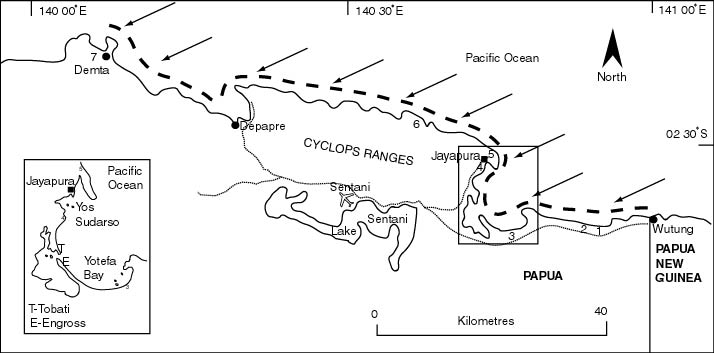 Figure 2: Map of the Jayapura coast. 1-Skouw Saey; 2-Skouw Mabo; 3-Holtekamp; 4-Hamadi market; 5-Base G beach; 6-Ormo coastline; and 7-Demta headland. The thick dashed line indicates the extent of the shoreline affected by the tsunami waves. Where observed, the waves approached from the east-northeast, as indicated by the arrows. The inset shows the location of Tobati (T) and Engross (E) villages.
 Figure 4: Sketch profile of the beach at Skouw Saey village (not to scale).
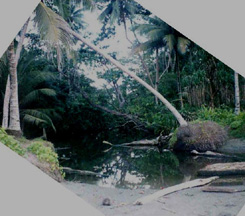 Figure 6: Photograph of a coconut palm at Skouw Saey village, the base eroded and moved by the backwash of the tsunami waves.
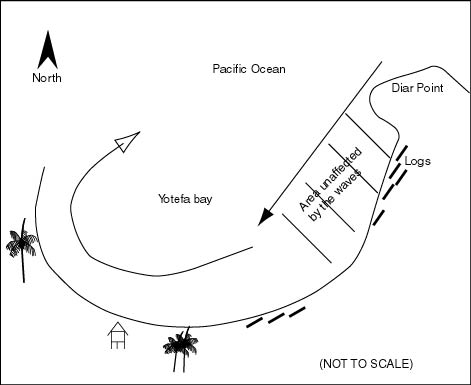 Figure 8: Sketch shows the behavior of the waves approaching Holtekamp beach. The waves appeared like a whirlpool to observers. The shaded area was unaffected by the incoming waves.
|